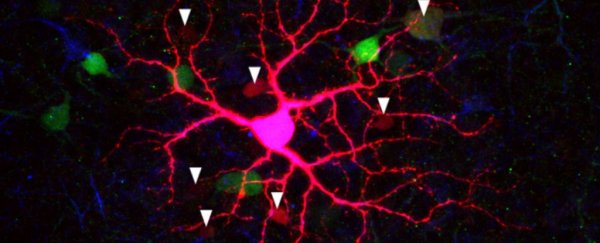When you opened your eyes for the very first time, the first thing you 'saw' was light. It was your mother's second trimester, and you were still snuggled up inside her womb.
Your brain, at the time, was rapidly developing, your lungs were fully formed (although not yet breathing), and your retinas were already detecting their first illumination.
Like all mammals, you were born functionally blind, but long before that, you could make out the world's brightness. Now, a new study on mice suggests that even in the womb, the mammalian eye is capable of seeing far more than we thought.
The first light-sensitive cells to develop in the retina are ipRGCs (intrinsically photosensitive retinal ganglion cells), which actually were only discovered a decade ago.
When mammals are first born, the rods and cones in their retinas, which allow them to make out colours and images, are not yet connected to the brain. It takes time and practice for strong links to properly develop, but recent research, mainly on mice and monkeys, reveals our sensitivity to light may develop much earlier.
Even as a foetus, animal studies have shown different ipRGCs relay information about ambient light to different parts of the mammalian brain, including areas concerned with pupil dilation and circadian rhythms.
So far, six subtypes of ipRGCs have been identified in total, but to this day we still don't know much about them or how they influence retinal development.
Researchers from the University of California Berkeley now say we've been underestimating what these photosensitive cells are truly capable of - at least, that is, in mice.
"In the past, people demonstrated that these light-sensitive cells are important for things like the development of the blood vessels in the retina and light entrainment of circadian rhythms, but those were kind of a light on/light off response, where you need some light or no light," explains cell biologist Marla Feller.
"This seems to argue that they are actually trying to code for many different intensities of light, encoding much more information than people had previously thought."
Dissecting the retinas of mice and using various forms of analysis and pharmacology, the authors show that all six types of ipRGCs in newborn mice are interconnected, talking to one another via electrical connections called gap junctions.
Not only does this web of information detect light, it also appears to respond to light's intensity, which can vary by nearly a billion-fold. This seems to suggest that even in the womb, mammalian retinas are encoding the subtleties of illumination.
"We thought that the ganglion cells were there in the developing eye, that they are connected to the brain, but that they were not really connected to much of the rest of the retina, at that point," says Feller.
"Now, it turns out they are connected to each other, which was a surprising thing."
Interestingly, while some of the subtypes of ipRGCs used gap junctions to speak with one another, others did not, which suggests they might all have different roles to play.
Together, the results reveal a neural circuit in which ipRGC type 2 and 5 are extensively connected and rely on detectable light, while ipRGC type 1 is isolated and generates its light response only through intrinsic means.
It's the gap junctions, the authors explain, that allow the whole neural circuit such diverse light responses.
"Given the variety of these ganglion cells and that they project to many different parts of the brain, it makes me wonder whether they play a role in how the retina connects up to the brain," ponders Feller.
"Maybe not for visual circuits, but for non-vision behaviours."
This could be, for example, what drives mammal pups to avoid light when they are first born.
Research on ipRGCs, however, is still gaining steam, and many more studies will be needed before we can say how these cells work, when they develop, and what behavioural responses they might induce.
Plus, while lab mice have been crucial models for human eye development, these creatures have a physiology that is substantially different to ours, with unusual photoreceptor adaptations in their eyes. Who's to say their retinal development will occur in the same way as our own species?
Even still, it's an interesting avenue of inquiry, and given the ethical quandaries surrounding developmental research on humans, mice are still some of the best models we have to learn more about our own eyes.
The study was published in Current Biology.
